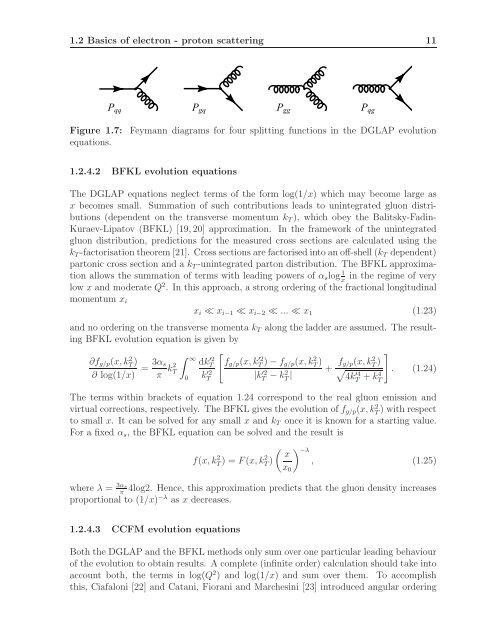10 - H1 - Desy
10 - H1 - Desy
10 - H1 - Desy
Create successful ePaper yourself
Turn your PDF publications into a flip-book with our unique Google optimized e-Paper software.
1.2 Basics of electron - proton scattering 11<br />
P qq P gq P gg P qg<br />
Figure 1.7: Feymann diagrams for four splitting functions in the DGLAP evolution<br />
equations.<br />
1.2.4.2 BFKL evolution equations<br />
The DGLAP equations neglect terms of the form log(1/x) which may become large as<br />
x becomes small. Summation of such contributions leads to unintegrated gluon distributions<br />
(dependent on the transverse momentum k T ), which obey the Balitsky-Fadin-<br />
Kuraev-Lipatov (BFKL) [19, 20] approximation. In the framework of the unintegrated<br />
gluon distribution, predictions for the measured cross sections are calculated using the<br />
k T -factorisation theorem [21]. Cross sections are factorised into an off-shell (k T dependent)<br />
partonic cross section and a k T -unintegrated parton distribution. The BFKL approximation<br />
allows the summation of terms with leading powers of α s log 1 in the regime of very<br />
x<br />
low x and moderate Q 2 . In this approach, a strong ordering of the fractional longitudinal<br />
momentum x i<br />
x i ≪ x i−1 ≪ x i−2 ≪ ... ≪ x 1 (1.23)<br />
and no ordering on the transverse momenta k T along the ladder are assumed. The resulting<br />
BFKL evolution equation is given by<br />
∂f g/p (x, kT 2)<br />
∂ log(1/x) = 3α ∫ [<br />
]<br />
∞<br />
s dk ′2<br />
π k2 T<br />
f g/p (x, k T ′2)<br />
− f g/p(x, kT 2 )<br />
T<br />
0 k<br />
T<br />
′2 |k<br />
T ′2 − k2 T | + f g/p(x, kT 2 √ ) . (1.24)<br />
4k<br />
′4<br />
T<br />
+ kT<br />
4<br />
The terms within brackets of equation 1.24 correspond to the real gluon emission and<br />
virtual corrections, respectively. The BFKL gives the evolution of f g/p (x, kT 2 ) with respect<br />
to small x. It can be solved for any small x and k T once it is known for a starting value.<br />
For a fixed α s , the BFKL equation can be solved and the result is<br />
f(x, k 2 T ) = F(x, k2 T ) ( x<br />
x 0<br />
) −λ<br />
, (1.25)<br />
where λ = 3αs 4log2. Hence, this approximation predicts that the gluon density increases<br />
π<br />
proportional to (1/x) −λ as x decreases.<br />
1.2.4.3 CCFM evolution equations<br />
Both the DGLAP and the BFKL methods only sum over one particular leading behaviour<br />
of the evolution to obtain results. A complete (infinite order) calculation should take into<br />
account both, the terms in log(Q 2 ) and log(1/x) and sum over them. To accomplish<br />
this, Ciafaloni [22] and Catani, Fiorani and Marchesini [23] introduced angular ordering
















